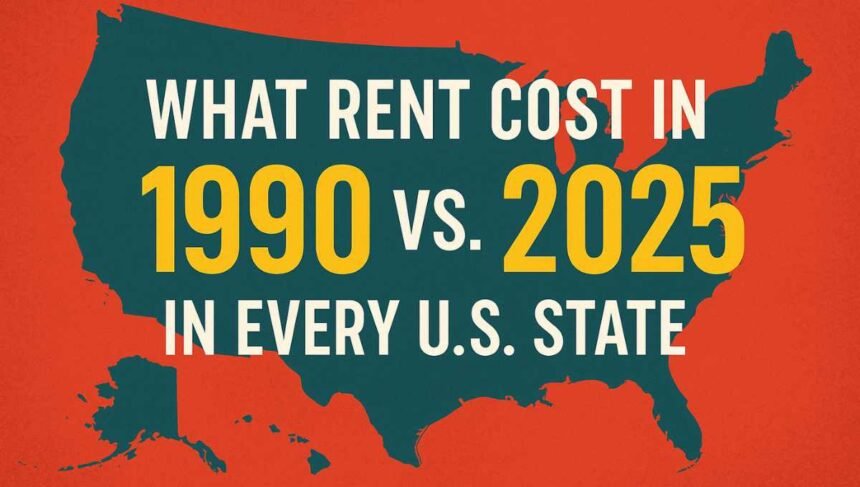Have you ever asked yourself: How much did rent used to cost? The answer may surprise you. In 1990, rent across the U.S. looked very different than it does today.
Thanks to data from the U.S. Census Bureau, we can now compare historical rent prices side-by-side with today’s costs after adjusting for inflation.
This blog post explores 1990 rent prices in every U.S. state, both as they were back then and as they would be adjusted to 2025 dollars.
Why Historical Rent Data Matters
Every ten years, the U.S. Census Bureau collects data about income, housing, population, and the cost of living. One of the key pieces of information is median gross rent. This includes not just rent payments but also utilities like electricity, gas, and water.
While rent prices change based on demand, location, and housing availability, this historical snapshot helps us better understand long-term affordability.
In 1990, the national median gross rent was $447. When adjusted for inflation, that’s about $1,115 in 2025. This gives us a benchmark to compare state-by-state rental costs.
Rent Prices in 1990 vs. 2025 (Adjusted)
Here’s a look at what people paid in each state back in 1990 and what those same rent prices would equal today:
| State | 1990 Rent | 2025 Adjusted |
|---|---|---|
| Alabama | $325 | $810 |
| Alaska | $559 | $1,394 |
| Arizona | $438 | $1,092 |
| Arkansas | $328 | $818 |
| California | $620 | $1,546 |
| Colorado | $418 | $1,042 |
| Connecticut | $598 | $1,491 |
| Delaware | $495 | $1,234 |
| District of Columbia | $479 | $1,194 |
| Florida | $481 | $1,199 |
| Georgia | $433 | $1,080 |
| Hawaii | $650 | $1,621 |
| Idaho | $330 | $823 |
| Illinois | $445 | $1,110 |
| Indiana | $374 | $933 |
| Iowa | $336 | $838 |
| Kansas | $372 | $928 |
| Kentucky | $319 | $795 |
| Louisiana | $352 | $878 |
| Maine | $419 | $1,045 |
| Maryland | $548 | $1,366 |
| Massachusetts | $580 | $1,446 |
| Michigan | $423 | $1,055 |
| Minnesota | $422 | $1,052 |
| Mississippi | $309 | $770 |
| Missouri | $368 | $918 |
| Montana | $311 | $775 |
| Nebraska | $348 | $868 |
| Nevada | $509 | $1,269 |
| New Hampshire | $549 | $1,369 |
| New Jersey | $592 | $1,476 |
| New Mexico | $372 | $928 |
| New York | $486 | $1,212 |
| North Carolina | $382 | $953 |
| North Dakota | $313 | $780 |
| Ohio | $379 | $945 |
| Oklahoma | $340 | $845 |
| Oregon | $408 | $1,017 |
| Pennsylvania | $404 | $1,007 |
| Rhode Island | $489 | $1,219 |
| South Carolina | $376 | $938 |
| South Dakota | $306 | $763 |
| Tennessee | $357 | $890 |
| Texas | $395 | $985 |
| Utah | $369 | $920 |
| Vermont | $446 | $1,112 |
| Virginia | $495 | $1,234 |
| Washington | $445 | $1,110 |
| West Virginia | $303 | $756 |
| Wisconsin | $399 | $995 |
| Wyoming | $333 | $830 |
States With the Highest Rent (Then and Now)
Some states were already expensive in 1990, and they remain among the most expensive today, even after adjusting for inflation:
- Hawaii: $650 in 1990 → $1,621 today
- California: $620 in 1990 → $1,546 today
- Connecticut: $598 in 1990 → $1,491 today
- New Jersey: $592 in 1990 → $1,476 today
- Massachusetts: $580 in 1990 → $1,446 today
These states tend to have strong job markets, limited housing supply, and high demand—all of which drive up rent prices.
States With the Lowest Rent (Then and Now)
Other states were much more affordable in 1990 and, even when adjusted for inflation, remain lower-cost today:
- West Virginia: $303 in 1990 → $756 today
- South Dakota: $306 in 1990 → $763 today
- Mississippi: $309 in 1990 → $770 today
- Montana: $311 in 1990 → $775 today
- North Dakota: $313 in 1990 → $780 today
These areas generally offer more rural living, lower population density, and more affordable housing options.
What Do These Comparisons Reveal?
When you look at both the original 1990 rent and the adjusted 2025 rent, a few things become clear:
1. Rent Has Mostly Tracked with Inflation
In many states, adjusted rent values align closely with what you might expect today. That means rent has generally kept pace with inflation over the long run.
2. Some Areas Have Surpassed Inflation
Places like California, New York, and Hawaii have seen rent prices far exceed inflation. This is often due to increased demand, growing populations, and limited housing availability.
3. Cheaper States Still Offer Affordability
If you’re looking for lower rent in 2025, states that were cheap in 1990 still offer relatively affordable living – especially in parts of the Midwest and South.
Then vs. Now: What’s Changed?
While it may seem that rent was cheap in 1990, incomes were also lower. People earned less, and the cost of living was different. What we can see, however, is that rent relative to income has become more difficult in many parts of the U.S.
In 1990, earning $30,000 per year made rent of $325–$450 very manageable. In 2025, even with inflation adjustments, rising rents in cities like Los Angeles, San Francisco, or New York often far outpace wage growth – making it harder for people to find affordable housing.







